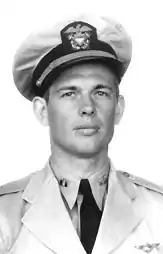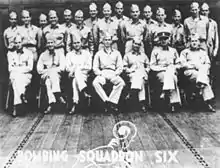Richard Halsey Best
Richard Halsey Best (March 24, 1910 – October 28, 2001) was a dive bomber pilot and squadron commander in the United States Navy during World War II. Stationed on the aircraft carrier USS Enterprise, Best led his dive bomber squadron at the 1942 Battle of Midway, sinking two Japanese aircraft carriers in one day, before being medically retired that same year due to damage to his lungs caused by breathing bad oxygen during the battle.
Richard Halsey Best | |
|---|---|
 | |
| Nickname(s) | Dick |
| Born | March 24, 1910 Bayonne, New Jersey, US |
| Died | October 28, 2001 (aged 91) Santa Monica, California, US |
| Buried | |
| Allegiance | United States |
| Service/ | United States Navy |
| Years of service | 1932–1942 |
| Rank | Lieutenant commander |
| Battles/wars | World War II |
| Awards | Navy Cross Distinguished Flying Cross |

Early life
Richard Halsey Best was born on March 24, 1910 in Bayonne, New Jersey, to Frank Ellsworth Best and Euretta L. Halsey. His grandparents were Richard James Best and Mary Ora Butler of New York, and William H. Halsey and Gusta Love of New Jersey. Richard married Doris Avis Albro (November 21, 1914 - December 6, 1968) on June 24, 1932 in Washington, D.C and they divorced on January 24, 1966.[1]
Early career (1928–1941)
_in_April_1942.jpg.webp)
Richard H. Best was appointed to the United States Naval Academy (USNA) in 1928. Having graduated with honors in 1932, he served for two years aboard the light cruiser USS Richmond. In 1934 he was transferred to the Naval Air Station Pensacola, Florida, as a naval aviation student. He completed his flight training in December 1935. His first assignment was Fighting Squadron Two (VF-2B) aboard the aircraft carrier USS Lexington, flying the Grumman F2F.
In June 1938, Best was given the choice to either join a patrol squadron at Panama or Hawaii, or become a flight instructor at Pensacola: he chose Pensacola, and was assigned to instruct Training Squadron Five. Anticipating what was probably coming, after a year and some months of instructing, Best decided that he could be of most use as a dive bomber pilot. He put in a request for a transfer to the Pacific Fleet in that capacity.
On May 31, 1940, Best received orders to join Bombing Squadron Six (VB-6), which was assigned to the aircraft carrier USS Enterprise. Upon arrival at the squadron's base on land, Naval Air Station North Island, California, on June 10, Best was made flight officer (operations officer) of the squadron, who was third-in-command. By early 1942, after the war in the Pacific had begun, he had advanced to executive officer (XO), a standard navy term for second-in-command, under his close friend and USNA classmate, William Hollingsworth, known as "Holly," as commander. Best subsequently became squadron commander in time for the Battle of Midway.[2]
War in the Pacific (1941–1944)
On December 7, 1941, Best was aboard Enterprise awaiting her return to port when he learned (along with most of VB-6) that several of his squadmates on morning search had flown into the Japanese attack on Pearl Harbor. That evening, he flew in the first Enterprise strike of the war as one of six SBDs carrying smoke generators. His group was tasked with providing cover for Lieutenant Eugene E. Lindsey's torpedo bombers should they find the Japanese carriers. However, the strike found nothing, and Best's group returned to Enterprise without incident, although he later called the resulting night landing "the worst...of [his] 330 carrier landings."[3]
Best saw his first real combat on February 1, 1942, flying in two strikes against the Marshall Islands. At dawn, he led VB-6's second division as part of a full-scale strike against Japanese shipping off Kwajalein. Before noon, he led eight SBDs from VB-6 and one from VS-6 to attack Taroa Island, Maloelap Atoll, a mission that would cost him one plane.[4] On February 24, 1942, Best took part in the attack of Wake Island by the Enterprise Air Group, and on March 4 Marcus Island was attacked. After these raids Enterprise returned to Pearl Harbor and accompanied USS Hornet during the Doolittle Raid in mid-April. Both carriers then sped to the south, but were too late to take part in the Battle of the Coral Sea. Both carriers and their sister ship USS Yorktown were then recalled to participate in what was to be the Battle of Midway.[5]
Battle of Midway
After contact reports from Midway-based PBY Catalina patrol aircraft on the morning of June 4, 1942, Enterprise started to launch her air group starting at 07:06. Under the overall command of the air group commander (CEAG) Lt.Cdr. Wade McClusky were 14 TBD-1 Devastator torpedo bombers of Torpedo Squadron 6 (VT-6), 34 SBDs of VB-6 and VS-6, and ten F4F-4 Wildcat fighters of Fighting Squadron 6 (VF-6). However, the squadrons became separated and reached the Japanese independently. Only the dive bombers stayed together and reached the Japanese by 09:55. At about 10:22, the Enterprise dive bombers (minus three that had dropped out with engine trouble) started to attack the two nearest Japanese carriers, Kaga and Akagi.
Sinking of Akagi
At this point, the attack became confused, as all 31 remaining Dauntlesses moved to attack Kaga. Best expected to attack according to U.S. dive bomber doctrine, which stated that the trailing squadron (VB-6) would attack the nearer target (in this case Kaga), while the leading squadron (VS-6) would take the farther of the two (here Akagi). However, McClusky, who had been a fighter pilot before becoming CEAG, was apparently unaware of this, and decided to lead VS-6 against Kaga. As the leading squadron dove past him, Best realized what was happening and broke off to attack Akagi. However, most of VB-6 missed his signal to abort and continued their dives on Kaga. Left with only his two wingmen, Best now had just three planes to attack Akagi.[6]


Best's three SBDs launched their attack at 10:26am. The first bomb, dropped by Lieutenant(jg) Edwin John Kroeger, hit the water opposite the carrier's bridge. The second bomb, dropped by Best, penetrated the flight deck and exploded in the upper hangar amongst 18 fuelled and armed Nakajima B5N2 aircraft.[8][9] The third bomb, dropped by Ensign Frederick Thomas Weber, exploded in the water near the stern, jamming Akagi's rudder.[10] Although only Best's bomb struck Akagi, the resulting fuel and ordnance-induced explosions in the confined hangar deck were enough to doom the carrier.
Sinking of Hiryū
Later that day, Best participated in the attack on the last remaining Japanese carrier, Hiryū, possibly scoring one of the four hits that sank her.[11] Best's gunner, James Francis Murray, believed that he "saw the flash of [Best's] bomb through the smoke as it struck [Hiryū] amidships forward of the island."[12] After the battle, Best was awarded the Navy Cross and the Distinguished Flying Cross.[13] The Citation said "Defying extreme danger from concentrated anti-aircraft barrage and powerful fighter opposition, Lieutenant Commander Best, with bold determination and courageous zeal, led his squadron in dive-bombing assaults against Japanese naval units. Flying at a distance from his own forces which rendered return unlikely because of probable fuel exhaustion, he pressed home his attacks with extreme disregard for his own personal safety. His gallant intrepidity and loyal devotion to duty contributed greatly to the success of our forces and were in keeping with the highest traditions of the United States Naval Service".[14] According to Stephen L. Moore, Best may have been "the first pilot to successfully bomb two Japanese carriers in one day".[12] Considering this unique accomplishment, Admiral Thomas Moorer and Vice Admiral William D. Houser made a serious but unsuccessful effort to recommend Best for the Medal of Honor after Best's death in 2001.[15]
Medical retirement
June 4, 1942, was the last day Best flew for the U.S. Navy. Just after Best landed on Enterprise, he began to cough up blood. Over the next twenty-four hours, his hemoptysis (coughing up blood) continued. He became acutely ill with a temperature of 103 °F (39 °C), and was admitted to Pearl Harbor Hospital.
Back in Pearl Harbor, Best was examined by the flight surgeon. During the morning flight on June 4 flying at 20,000 ft (6,100 m) several VB-6 pilots had encountered difficulties with oxygen supply, so Best gave the order to reduce the altitude to 15,000 ft (4,600 m).[16] The oxygen rebreather of Best's SBD had become heated during the unusually long search on the morning mission on June 4. The material used in the rebreather to remove exhaled carbon dioxide was sodium hydroxide. If the device containing this material were abnormally heated, it could release caustic soda fumes through the pilot's oxygen mask; consequently Best had inhaled caustic fumes. Sometime in the past, Best had contracted latent tuberculosis, which remained in his lungs in an inactive state for years. The inhaled caustic fumes caused an aspiration pneumonia and eroded away a tuberculosis granuloma, transforming the inactive form of the organism into an active form, resulting in the progression from latent TB infection to TB disease. Best was transferred from Pearl Harbor Hospital to Fitzsimons General Hospital in Aurora, Colorado, where he received proper treatment for his tuberculosis. Best was hospitalized in Fitzsimons Hospital until September 1943. He retired from the U.S. Navy in 1944 with a 100% disability.[17]
Civilian life (1944–2001)
After his retirement from the Navy, Best moved to Santa Monica, California, where he lived for the rest of his life. After discharge from the hospital, Best worked in a small research division of the Douglas Aircraft Corporation. This division became part of the Rand Corporation in December 1948, where Best headed the security department until his retirement in March 1975.[18] Best wrote the preface to the manual of Battlehawks 1942 flight simulation video game released in 1988 by LucasFilm Games. He died on October 28, 2001 and was buried at Arlington National Cemetery.[19] Best was married and had a daughter (Barbara Ann Llewellyn), a son (Richard Halsey Best II) a grandson, and a step-daughter (Amy Best). Best was 91 years old. [19]
References
- "FamilySearch". www.familysearch.org. Retrieved 2020-03-07.
- Hernandez, Daniel V.; Best, Richard H. (2004). SBD-3 Dauntless and the Battle of Midway. Valencia, Spain: Aeronaval Publishing. p. 7. ISBN 84-932963-0-9.
- Cressman and Wenger, Steady Nerves and Stout Hearts, p.53
- "Bombing Six Action Report: 1 February 1942". cv6.org. Retrieved 2019-04-10.
- "Battle of Midway: June 4–6, 1942". cv6.org.
- Robert J. Cressman: A Glorious Page in our History. The Battle of Midway 4 – June 6, 1942. Pictoral Histories Publishing Co., Missoula 1990, pp. 101–102. ISBN 0-929521-40-4
- Parshall and Tully, p. 239; Cressman, et al., p. 103
- Jonathan/Tully, pp. 241–242
- "Midway 42: IJN Carrier Damage"
- Jonathan Parshall, Anthony Tully: Shattered Sword: The Untold Story of the Battle of Midway, Washington 2005, p. 257. ISBN 978-1-57488-923-9
- Parshall/Tully say that it is difficult to assess who hit Hiryū (p. 326).
- Moore 2014, p. 289
- "Navy.togetherweserved: Best, Richard H., LCDR"
- "Richard Best – Recipient". valor.militarytimes.com. Retrieved 2020-02-19.
- Moore 2014, p. 355
- "VB-6 action report, 4–6 June 1942"
- Gordon W. Prange: Miracle at Midway. Penguin Books, London/New York 1982, pp. 273–274. ISBN 0-14-006814-7; Best's battle account: http://www.immf-midway.com/midway_itow_best.html
- Hernandez, p. 7.
- "Ed Skrein Wants Midway To Honor All Of The Men Who Fought In That Battle". cinemablend.com. November 8, 2019. Retrieved November 6, 2020.
Bibliography
- Cressman, Robert J., and Wenger, J. Michael, Steady Nerves and Stout Hearts: The Enterprise (CV-6) Air Group and Pearl Harbor, 7 December 1941. Pictorial Histories Publishing Co., Missoula 1990. ISBN 0929521250
- Moore, Stephen L. (2014). Pacific Payback: The Carrier Aviators Who Avenged Pearl Harbor at the Battle of Midway. New York: Penguin Group.CS1 maint: ref=harv (link)
External links
| Wikimedia Commons has media related to Richard Halsey Best. |